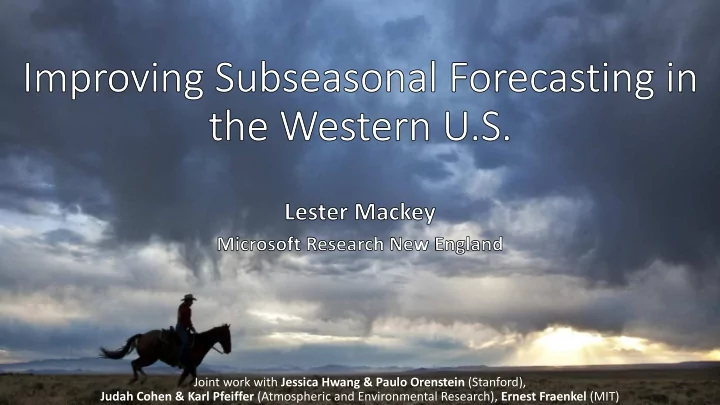

Joint work with Jessica Hwang & Paulo Orenstein (Stanford), Judah Cohen & Karl Pfeiffer (Atmospheric and Environmental Research), Ernest Fraenkel (MIT)
Goals • Awareness: Subseasonal forecasting • Crowdsourced science: The Subseasonal Climate Forecast Rodeo • The SubseasonalRodeo Dataset: https://doi.org/10.7910/DVN/IHBANG • Machine learning: Weighted locally linear regression, multitask model selection, multitask KNN, ensembling
Judah Cohen • Climatologist, director of seasonal forecasting at Atmospheric and Environmental Research • Concern: Community not making the best use of historical data in weather / climate forecasting • Landscape dominated by dynamical models , purely physics-based models of atmospheric and oceanic evolution
Dynamical Models • Initialized with current weather conditions inferred from measurements • Simulate future weather / climate by discretizing partial differential equations using supercomputers • Accuracy limited by chaotic nature: initial error doubles every 5 days • Ensembles with varying initial conditions / model parameters often formed to capture uncertainty • Sometimes debiased by comparing Source: http://celebrating200years.noaa.gov/breakt predictions to truth over recent years hroughs/climate_model/AtmosphericModel Schematic.png
Judah Cohen • Climatologist, director of seasonal forecasting at Atmospheric and Environmental Research • Concern: Community not making the best use of historical data in weather / climate forecasting • Landscape dominated by numerical weather prediction and global climate models , purely physics- based models of atmospheric and oceanic evolution • Concern: Subseasonal forecasts especially poor
Source: https://iri.columbia.edu/news/qa-subseasonal-prediction-project/
Subseasonal Forecasting: What and Why? • What: Predicting temperature and precipitation 2 – 6 weeks out • Why: (White et al., 2017, Meteorological Applications) • Allocating water resources • Managing wildfires • Preparing for weather extremes • e.g., droughts, heavy rainfall, and flooding • Crop planting, irrigation scheduling, and fertilizer application • Energy pricing
U.S. Bureau of Reclamation • “The mission of the [USBR] is to manage, develop, and protect water and related resources in an environmentally and economically sound manner in the interest of the American public.” • Manages water in 17 western states • Provides 1 out of 5 Western farmers with irrigation water for 10 million farmland acres • Generates enough electricity to power 3.5M U.S. homes • “During the past eight years, every state in the Western United States has experienced drought that has affected the economy both locally and nationally through impacts to agricultural production, water supply, and energy.” Credit: David Raff, USBR
The Subseasonal Climate Forecast Rodeo • A year long, real-time subseasonal forecasting competition • Designed to • Advance science • Raise awareness • Provide an evaluation platform Credit: David Raff, USBR
Subseasonal Rodeo Forecasts • Four separate forecasting tasks • Two variables: average temperature (degrees C) and total precipitation (mm) • Two outlooks: weeks 3-4 and weeks 5-6 (forecast is over a 2-week period) • Issued on a 1 ∘ ×1 ∘ latitude-longitude grid ( G = 514 grid points ) • Issued every two weeks • Apr 18, 2017 -- May 3, 2018, midnight GMT • Disqualified if two submissions missed • One submission was on Christmas day EST • Uploaded to server in NetCDF format • Popular format for scientific array data Acknowledgment: We would not have survived this competition without tools like CDO, wgrib2, and NCO for processing the NetCDF, GRIB2, and custom byte stream (?!) formats common in meteorological data
Recommend
More recommend